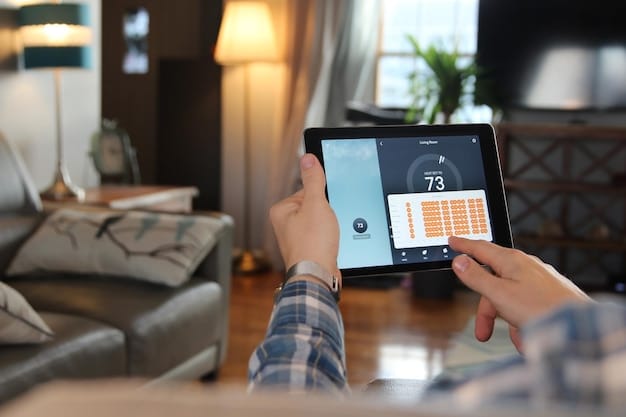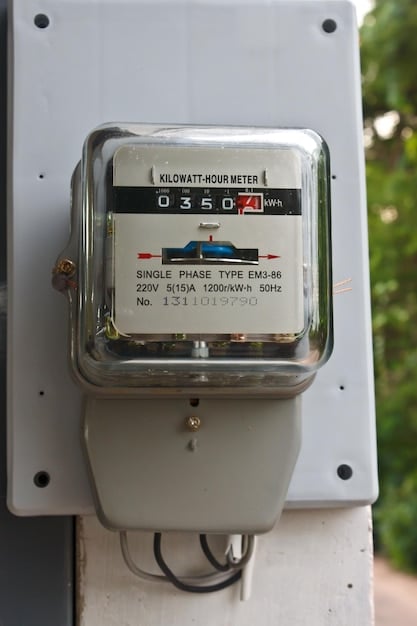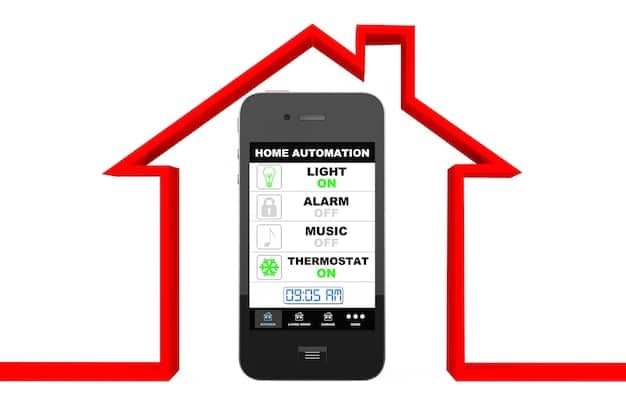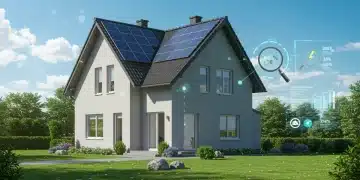Smart Home Energy Monitoring: Track & Reduce Energy Usage

Smart home energy monitoring empowers homeowners to track their energy consumption in real-time, identify energy-wasting appliances, and make informed decisions to reduce their energy usage and save money on their utility bills.
Want to take control of your energy bills and create a more sustainable home? Smart home energy monitoring offers the visibility you need to understand where your energy is being used and how to reduce your consumption, leading to significant savings and a smaller environmental footprint.
Understanding Smart Home Energy Monitoring
Smart home energy monitoring systems provide a detailed view of your energy usage, allowing you to pinpoint areas where you can conserve energy. These systems go beyond traditional utility bills, offering real-time data and insights.
But how exactly do these systems work, and what are the key components involved?
How it Works
These systems typically involve installing smart meters or energy monitors that track electricity usage at the circuit level or for individual appliances. The data is then transmitted wirelessly to a central hub or cloud platform, where it’s analyzed and presented to the homeowner through a user-friendly interface.
Key Components
The key components of a smart home energy monitoring system include:
- Smart Meter or Energy Monitor: Measures energy consumption in real-time.
- Data Hub: Collects and transmits data from the energy monitor to the cloud.
- Software or App: Displays energy usage data and provides insights.
With this information at your fingertips, you can make informed decisions about your energy consumption habits.

Ultimately, understanding how smart home energy monitoring works is the first step toward taking control of your energy usage and creating a more energy-efficient home.
Benefits of Real-Time Energy Monitoring
Real-time energy monitoring offers a multitude of benefits, from saving money to reducing your environmental impact. The ability to see your energy usage as it happens allows for immediate identification of energy-wasting behaviors.
Let’s dive into specifics:
- Cost Savings: By identifying energy-hungry appliances and adjusting your usage, you can significantly reduce your monthly energy bills.
- Reduced Environmental Impact: Conserving energy reduces your carbon footprint and contributes to a more sustainable future.
- Improved Energy Efficiency: Real-time data helps you identify inefficiencies and optimize your energy usage.
- Increased Awareness: Understanding your energy consumption patterns allows you to make informed decisions about your energy usage.
By taking advantage of these benefits, you can create a more energy-efficient and sustainable home.
In summary, real-time energy monitoring provides valuable insights that can lead to significant cost savings and a reduced environmental impact.
Choosing the Right Monitoring System
Selecting the right smart home energy monitoring system can feel overwhelming with the array of options available. However, by considering a few key factors, you can find a system that fits your needs and budget.
Here’s what to consider:
Key Factors to Consider
When choosing a system, evaluate the following aspects:
- Compatibility: Ensure the system is compatible with your existing smart home devices and platform.
- Installation: Consider whether you prefer a DIY installation or professional setup.
- Features: Look for features such as real-time monitoring, historical data analysis, and energy-saving recommendations.
Popular Systems
Some of the more popular smart home monitoring systems include:
- Sense Energy Monitor: Offers detailed appliance-level monitoring.
- Emporia Energy Monitor: Provides affordable whole-home energy monitoring.
- Neurio WATTBOX: Integrates with solar panel systems for comprehensive energy management.

Ultimately, the best system depends on your specific needs and energy consumption patterns.
Selecting the right energy monitoring system requires careful consideration of your needs, budget, and desired features.
Practical Tips to Reduce Energy Usage
Once you’ve installed a smart home energy monitoring system, the real work begins: implementing strategies to reduce your energy usage. With real-time data at your fingertips, you can identify the most energy-intensive areas of your home and take targeted action.
- Identify Energy Vampires: Unplug electronics and appliances when not in use to eliminate standby power consumption.
- Upgrade Appliances: Replace older, inefficient appliances with Energy Star-certified models.
- Adjust Thermostat Settings: Program your thermostat to lower the temperature when you’re away or asleep.
By following these practical tips, you can significantly reduce your energy usage and save money.
More Energy Saving Strategies
Consider the following to maximize savings:
- Seal air leaks around windows and doors.
- Use energy-efficient lighting (LEDs).
- Wash clothes in cold water.
These small changes can add up to significant savings over time.
In conclusion, reducing energy usage is an ongoing process that requires awareness and commitment. With the help of smart home energy monitoring, you can make informed decisions and create a more energy-efficient home.
Understanding Energy Consumption Patterns
A significant benefit of using a smart home energy monitoring system is its power to help users thoroughly analyze their energy consumption patterns. Recognizing these patterns is the key to effectively reducing energy waste and increasing savings.
Here’s how to do it:
How to Analyze Your Data
Analyzing your data will allow you to figure out actions to take. To do so, explore these common points:
- Identify Peak Usage Times: Determine when your energy consumption is highest and adjust your usage accordingly.
- Pinpoint Energy-Hogging Appliances: Identify the appliances that consume the most energy and consider upgrading or replacing them.
- Track Changes Over Time: Monitor your energy usage over time to see the impact of your energy-saving efforts.
Regularly reviewing this data will enable you to identify trends and areas needing improvement.
By understanding your energy consumption patterns, you can make informed decisions about your energy usage and achieve significant savings.
The Future of Smart Home Energy Monitoring
The field of smart home energy monitoring is constantly evolving, with new technologies and features emerging all the time. As technology advances, we can expect even more sophisticated and user-friendly systems that provide deeper insights into our energy usage.
What can we expect?
Emerging Technologies
Some of the emerging technologies in smart home energy monitoring include:
- AI-Powered Energy Management: Systems that use artificial intelligence to optimize energy usage automatically.
- Integration with Renewable Energy Sources: Seamless integration with solar panels and other renewable energy sources.
- Predictive Analytics: Systems that can predict your future energy usage and provide personalized recommendations.
These advancements promise to make energy management even more efficient and convenient.
Smart home energy monitoring will become even more sophisticated and integrated into our lives, helping us create more sustainable and energy-efficient homes. With advancements on the horizon, real savings at tangible.
| Key Aspect | Brief Description |
|---|---|
| 💡 Real-Time Tracking | Monitors energy usage to identify immediate savings. |
| 💰 Cost Reduction | Helps lower utility bills through informed habits. |
| 🌱 Eco-Friendly | Reduces carbon footprint promoting sustainability. |
| ⚡ Smart Upgrades | Suggests improvements in appliance efficiency. |
Frequently Asked Questions
Smart home energy monitoring is the process of tracking your home’s energy usage in real-time, typically through smart meters, energy monitors, and software applications. It allows you to understand your energy consumption patterns and identify areas for improvement.
Real-time monitoring helps you identify energy-wasting appliances and habits. By seeing your energy usage as it happens, you can make immediate adjustments, such as turning off lights and unplugging electronics, to reduce your energy bills.
Many smart home energy monitoring systems are designed for DIY installation, while others require professional setup. Depending on your comfort level and the complexity of the system, you can choose the option that works best for you.
Look for features such as real-time monitoring, historical data analysis, appliance-level monitoring, energy-saving recommendations, and compatibility with your existing smart home devices. Choose a system that meets your specific needs and budget.
Use the software or app provided with your energy monitoring system to view your energy usage data. Identify peak usage times, energy-hogging appliances, and trends over time. Use this information to make informed decisions about your energy usage.
Conclusion
Smart home energy monitoring is a powerful tool for reducing your energy consumption, saving money, and creating a more sustainable home. By understanding your energy usage patterns and taking proactive steps to conserve energy, you can make a significant impact on your wallet and the environment.





